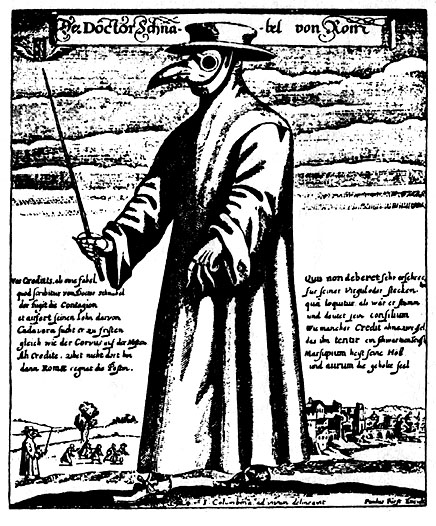
I was watching a documentary on The Black Death that I got off of Itunes and I was skimming wikipedia for some extra info. In the process, I came across something very interesting. Look's like someone on the RE5 development staff likes European History.
Now considering Resident Evil 5 is all about bio-weapons capable of causing a new black death (in scale and scope, if not even worse), the idea of someone trying to protect themselves for the disease wearing this outfit (or at least a hightech upgrade) has an interesting comparison to history. I'd be pretty shocked if this wasn't some sort of factor in Birdlady's design, even more so considering the strong speculation on who she is.
Here is a little more info on this early version of a Bio-Hazard Protection Suit.
http://en.wikipedia.org/wiki/Consequences_of_the_Black_Death
Considered an early form of hazmat suit, a plague doctor's clothing consisted of:
* A wide-brimmed black hat worn close to the head. At the time, a wide-brimmed black hat would have been identified a person as a doctor, much the same as how nowadays a hat may identify chefs, soldiers, and workers. The wide-brimmed hat may have also been used as partial shielding from infection.
* A primitive gas mask in the shape of a bird's beak. A common belief at the time was that the plague was spread by birds. There may have been a belief that by dressing in a bird-like mask, the wearer could draw the plague away from the patient and onto the garment the plague doctor wore. The mask also included red glass eyepieces, which were thought to make the wearer impervious to evil. The beak of the mask was often filled with strongly aromatic herbs and spices to overpower the miasmas or "bad air" which was also thought to carry the plague. At the very least, it may have served a dual purpose of dulling the smell of unburied corpses, sputum, and ruptured bouboules in plague victims.
* A long, black overcoat. The overcoat worn by the plague doctor was tucked in behind the beak mask at the neckline to minimize skin exposure. It extended to the feet, and was often coated head to toe in suet or wax. A coating of suet may have been used with the thought that the plague could be drawn away from the flesh of the infected victim and either trapped by the suet, or repelled by the wax. The coating of wax likely served as protection against respiratory droplet contamination, but it was not known at the time if coughing carried the plague. It was likely that the overcoat was waxed to simply prevent sputum or other bodily fluids from clinging to it.
* A wooden cane. The cane was used to both direct family members to move the patient, other individuals nearby, and possibly to examine the patient with directly.
* Leather breeches. Similar to waders worn by fishermen, leather breeches were worn beneath the cloak to protect the legs and groin from infection. Since the plague often tended to manifest itself first in the lymph nodes, particular attention was paid to protecting the armpits, neck, and groin. It is not known how often or widespread plague doctors were, or how effective they were in treatment of the disease. It's likely that while offering some protection to the wearer, they may have actually contributed more to the spreading of the disease than its treatment, in that the plague doctor unknowingly served as a vector for infected fleas to move from host to host.
No comments:
Post a Comment